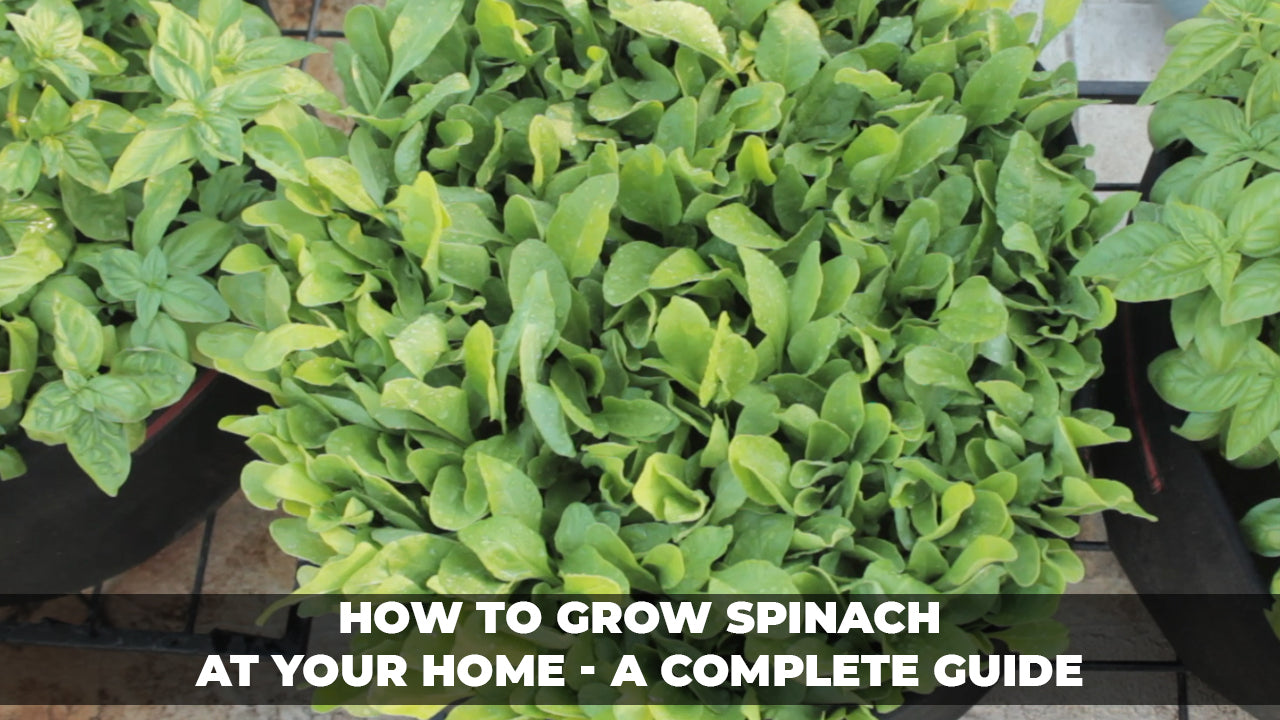How to Grow
How to grow spinach at your home
Greens can be grown anywhere if there is an availability of sunlight. Like vegetables or fruits, greens are not heavy feeders. These greens do not require regular fertilizing to reward you with fresh tender leaves. They can be grown anywhere like balcony, terrace, or in your kitchen gardens. Spinach is among those wonderful greens high in fiber, iron, calcium, folic acid, and proteins.
Spinach:
Spinach is one of the nutritious leafy greens whose leaves are packed with a lot of vitamins, minerals, and antioxidants. It can be either cooked or served raw in salads. Their leaves contain vitamins like A, B6, B9, C, E, and K1 and are loaded with various health benefits.

Health benefits of spinach:
- Good for skin, hair, and bone health.
- Reduce the risks of causing cancers.
- Lowers blood pressure.
- Controls blood sugar levels.
- Prevents constipation and helps in maintaining a healthy gut.
How to grow spinach:
Spinach is a cool-weather crop yet can be grown all year round except in hot summers. It just takes 40-45 days from sowing to harvest a batch of spinach plants. Let’s look into the requirements that are essential for growing spinach in a completely organic way.

Requirements to grow spinach:
- Basic gardening tools and watering tools: such as pruning shears, gardening trowel, fork and cultivator, watering can, pressure sprayer.
- Grow bag/pot/any container that is suitable to grow spinach.
- Soil: Well-drained soil that has pH 6.5 - 7.0.
- Seeds: Seeds from a trusted source.
- Sowing time: All year round (except in mid-April to mid-June and mid-November to mid-Feb).
- Germination temperature: 10℃ - 22℃.
- Light: Full sun to partial shade.
Step by step guide to grow spinach at your home, terrace or in your balconies:
- Take a suitable container and fill it with well-drained soil/potting mix that is organic, fertile, and free of pathogens and weed seeds.
- Sway the grow bag/pot to remove the excess air pockets and give a modest press to the soil so that seeds do not move deep when it is watered.
- Make straight rows with the help of a gardening fork if you intend to grow them in rows.


- Drop spinach seeds on those rows and cover them with soil or sprinkle the seeds randomly (without clusters) and cover them with a thin layer of soil., if you do not want to sow them in rows.
-
Now water the soil thoroughly with the help of a watering can/hose pipe that has a shower nozzle. Watering without the nozzle results in producing holes (sort of) that result in pushing the seeds deep into the soil. It also leads to uneven soil surface.


- Place the grow bag/pot in partial shade until they germinate. You can even place them in full sun by carefully regulating the moisture level of the soil.
- Maintain the soil moist until the seeds germinate and establish well.
-
Within 10- 14 days you could see the germination. After the germination of all seeds, remove the week seedlings and transplant the healthy seedlings into another pot if they are overcrowded.


- From now water them only when the top inch layer of the soil becomes slightly dry.
-
If maintained properly, spinach leaves will come to harvest within 40-45 days.

- Now you can either pull them entirely or cut/pinch the leaves above soil level if you intend to get few (two or three) more harvests from them.

Caring tips to grow spinach:
- Keep a regular check on plants to detect the early signs of diseases and pest infestations. Pull out the diseased or weak plants (if 1 or 2 in number) as they harbor pests and disease-causing pathogens.
- Remove the leaves that are in close contact with the soil to facilitate the healthy growth of plants.
- You can fertilize (optional) them after one month of sowing with any low concentrated fertilizer like vermicompost (contains water-soluble nutrients) to boost their healthy growth.
- Pull out the weeds regularly as they slow down the growth by competing with spinach plants for available water and nutrients in the soil.

- Keep the foliage dry to reduce the risks of pests and diseases.
-
Do not damage the growing point (base of the plant) while harvesting spinach leaves. Cut/pinch the leaves one or two inches above the soil level to get more harvests from the spinach plants.


Pests and diseases of spinach:
-
Pests that attack spinach: Pests like spider mites, aphids, and flea beetles may attack the plants at any stage of plant growth.
Solution: Use neem oil to kill pests and prevent the plants from further infestations
-
Diseases of spinach: Diseases like leaf spot, downy mildew, root rot may cause damage to your plants.
Solution: Use neem powder in the potting mix if your soil/garden soil facilitates root rots.
Use neem oil to control leafspot and downy mildew as it acts as both fungicide and bactericide.
-
Bolting: The phenomenon of producing seeds by a premature plant (producing flowers early) and making it unsuitable for consumption is known as bolting. It occurs when a plant undergoes stress in its growing period.
In spinach, this situation generally takes place due to stress factors like inadequate watering, too much sunlight by which the spinach plant starts producing flowers, and a change in the taste and flavor of leaves occurs.
Solution: Water them thoroughly and let the soil become slightly dry between watering.
Protect these sensitive greens from harsh sunlight (noon light) using shade nets.
Adverse effects of spinach:
- Spinach contains good amounts of calcium and oxalates that are good for bone health. It is not recommended for people who are at risk of developing kidney stones because calcium oxalate present in spinach may lead to acid and mineral salt build-up and result in forming kidney stones in them.
- Generally, vitamin k1 is essential in blood clotting in our body. People who use blood thinners are not supposed to intake spinach (in larger amounts) as it is rich in vitamin K1.
Click here to know how to grow lettuce from seeds
Click here to know how to grow methi from seeds
Frequently asked questions:
1. How long does it take for spinach from seed to harvest?It just takes 40- 45 days when you maintain spinach plants properly by keeping a regular check on pests and diseases. Because pests, diseases, weeds are the main reason to slow down the growth of any plants.
2. What is the best time to plant spinach seeds?
Spring is the best time to sow spinach while it can be grown all year round except in hold summers.
3. When to harvest the spinach leaves?
You can pull out or cut the spinach leaves when they are fully grown (around 15 cm). Leaving the leaves to overgrow reduces their tenderness and tastes.
4. Can I expect a healthy harvest from bolted spinach plants after cutting their leaves and flower stems?
Spinach is an annual plant that completes its life cycle in one season after producing seeds. If once spinach started producing flowers (contains seeds), the quality of the leaves gets altered making it unsuitable for consumption. So you cannot expect a further harvest from the bolted spinach plants.
5. Does spinach grow back after cutting?
Yes. spinach does grow back to give you two or three harvests if you do not harm the growing point (base of the stem) of the spinach plants. So cut leaves 1 or two inches above the base of the stems.
6. Are leaves from a bolted spinach plant poisonous?
Leaves of a bolted spinach are indeed inedible but they are definitely not poisonous. Their leaves become bitter/tasteless due to bolting as the plant diverts its energy to produce flowers and seeds.
Popular Searches: Garden Accessories for Sale, Compost Bin India, Plastic Flower Pots Online, Contemporary Plant Pots, Hanging Pots Online, Colourful Plant Pots, Bird Feeders Online, Rectangular Planters Online, Small Pots Online, Flower Pots Online, Kitchen Waste Compost Bin, Balcony Railing Planter, Buy Pots Online, Indoor Plant Pots, Metal Flower Pot



